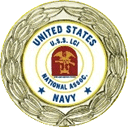LCI SAILOR HONORED & NOT FORGOTTEN: Bill Simmons LCI(M) 756 passed away in January 2019. This tribute appeared in his American Legion newsletter. He will always be held in great respect by members of Tattler Post 973 in Chicago. This tribute was shared by the Simmons family along with photos and navy memorabilia. His full story including the details from the above article will appear in our June Elsie Item.
Chicago born and raised, William H. Simmons enlisted in the United States Navy on 27 June 1944. He was 17-years-old.
The Navy sent him to the Farragut Naval Training Station in Idaho and then on to the West Coast and Hawaii. He was assigned as a crewman on the USS LCl(L) 756, a landing craft, 158 feet in length, that could carry as many as 200 men. However, LCl(L) 756 (no name was ever given) was about to undergo a transformation from landing craft to gunboat – a vessel which would support men ashore with heavy mortar fire. The ’56 was outfitted with three 4.2″ chemical mortars. Also, the ship’s company was increased to five officers and 45 men (“History of USS LCl(L) 756”). Bill Simmons was one of those men.
In January 1945, the ’56 was part of LCl(L} Group Forty-six, one of three groups of LCI Mortar Flotilla Twenty-one. headed for a destination unknown. That destination turned out to be “Bloody Little lwo.”
According to the “Ship’s History,” “Books will record February 19. 1945 as the day that lwo Jima first felt the heel of the United States Marines and the mortar shells of the LCl(L) 756. H-Hour, 0900, found the 756 already on the right flank of the Fourth Martine Division pouring chemical mortar shells into the east boat basin and stone quarry, which housed many gun emplacements and pillboxes…
“The ’56 spent but eight days and seven nights in the waters around lwo … but hundreds of gallons of fog oil were expended to protect the larger fleet units from hostile air attacks; and over 2700 rounds of mortar ammunition were thrown at that eight square mile island- mostly in night harassing missions on the northwest end of Jap-held lwo.” On 26 February, the 756 left for Saipan.
A report of the lwo Jima operation states, “The successful use of mortar gunboats throughout the early days of the assault was one of the outstanding features of this operation. The standard procedures developed during the training period proved adequate and the fire from these vessels was quite accurate and extremely effective.” (Report, Commander Amphibious Group Two, 9 April 1945)
The next engagement of Bill and the 756 was Okinawa, where on the morning of April 1 , “the ’56’s position this time was at the fore leading the assault craft to the beaches… paving the way for the safe beachhead for infantry troops.” (“Ship’s History”)
Mercifully the war ended, and Bill headed home to Chicago after almost two years of service.
The noteworthy accomplishments, perseverance, and devotion to duty of Electrician’s Mate Third Class William Simmons reflect credit upon himself and uphold the highest traditions of the United States Naval Service. Thanks to him and over 16 million other Americans in uniform during World War II, we have a free country.
